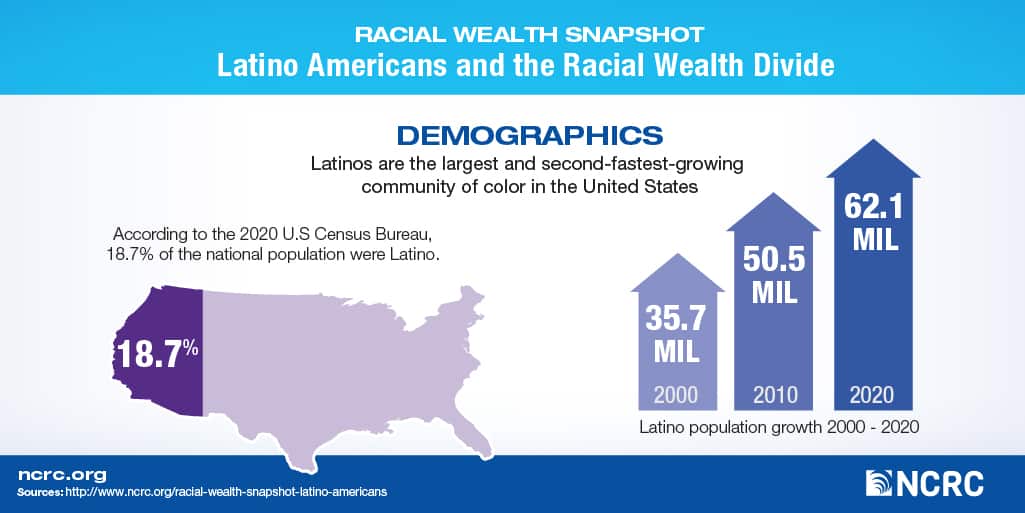In honor of Latino Heritage Month, this is one in a series of NCRC snapshots and infographics exploring racial economic and wealth disparities and the economic conditions of various Latino nationalities.
The Latino population has experienced record population growth, accounting for about half of total population growth from 2010 to 2019. This growth corresponds with their increased centrality as a pillar of the American economy. The total economic output of Latino Americans, as measured in GDP, was valued at $2.6 trillion in 2018. Latinos are indelible to the American workforce, currently comprising 18% of the workforce, and this share is projected to increase to 20% by 2030. Latinas in particular were projected to increase their labor force share by 25.8% — almost nine times the projected growth of White women in the labor force. In 2019, the median household income of Latinos reached a new high of $56,110, about $13,000 less than the median household income for all Americans. Median wealth also reached record heights in 2019, reaching a value of about $14,000. This increase in wealth is something that hopefully can continue to grow. It will need to in order to bridge the racial wealth divide. The record level median wealth for Latinos at $14,000 is still only 9% of median White wealth in 2019.
While Latinos recently have experienced important economic growth over the last couple of years, Latinos have also faced disproportionately negative impacts on public health, workforce and renters who face greater risk of eviction during this COVID crisis.
Latinas have been particularly hard-hit by the pandemic. Between March 2020 and March 2021, Latinas were the demographic with the largest exit from the workforce (-2.74%). Notably, Latinas experienced a poignant decline in the workforce in fall 2020, as school began. 337,000 Latinas dropped out of the labor force — again the highest decline among all demographic groups — likely due to childcare duties.
Latinas spend more time at home tending to domestic responsibilities than their male counterparts, and have higher rates of single parenthood than White mothers. Latinas’ 2021 labor force participation rate (55.5%) has not returned to its pre-pandemic levels (57.7%). For context, White women’s pre-pandemic labor force participation rate was 56.6%, and is currently 55.4%.[1]
At the same time, record low interest rates made mortgage payments more affordable for those who otherwise couldn’t have become homeowners, leading to over 700,000 mortgages procured by Latinos in 2020, with nearly half of these homebuyers being under the age of 34. In 2019, the homeownership rate for Latino Americans was 47.5%. Latinos have accounted for over 50% of US homeownership growth in the past 10 years and with one in three Latinos currently in the prime home buying years of 25 – 44, Latinos will likely drive the projected homeownership growth over the next 20 years.
The trends thus far exhibited both before and during the pandemic illustrate the economic challenges and future opportunities facing Latino Americans. Over the last few years, Latino Americans have seen progress in a series of socio-economic indicators but little that substantively bridges racial economic inequality with Whites nor makes most Latino households substantially more economically secure. The growth of Latino Americans in 21st century America is an important development and points to the growing importance of the necessity of the United States to bridge racial economic inequality.
Jamie Buell is NCRC’s Racial Economic Equity Coordinator.
Joshua Devine is NCRC’s Director of Racial Economic Equity
Dedrick Asante-Muhammad is NCRC’s Chief of Membership, Policy and Equity.
Photo by Rowan Heuvel on Unsplash.
- Bureau of Labor Statistics’ analysis of Current Population Survey data; civilian labor force participation rate for Latino women [Series LNU01300011Q] and white Women [Series LNU01392174Q] retrieved from https://data.bls.gov/PDQWeb/ln ?



